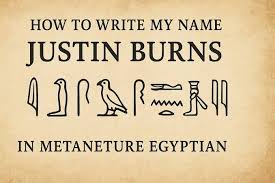Introduction
Have you ever caught yourself wondering, “How to write my name Justin Burns in Metaneture Egyptian?” At first glance, it sounds like a riddle blending ancient mysteries with modern self-expression. But the truth is, humans have always been fascinated by connecting their names, their identities, and their stories with cultural scripts that feel timeless.
Ancient Egyptian writing systems—whether hieroglyphics, hieratic, or later interpretations—carry more than just words. They embody spirituality, power, art, and the very fabric of human communication. Now, combine that with the mysterious concept of Metaneture Egyptian, which refers to the sacred and spiritual essence of writing. Suddenly, your name doesn’t feel like just a label anymore; it becomes a piece of heritage woven into symbolic language.
This article will take you on a journey: we’ll explore what Metaneture Egyptian means, how writing worked in ancient Egypt, and finally, how you could attempt to write “Justin Burns” in such a system. Along the way, expect a bit of imagination, a touch of humor, and maybe even a few “aha!” moments.
What on Earth is Metaneture Egyptian?
Before we tackle how to write my name Justin Burns in Metaneture Egyptian, let’s slow down for a second. What exactly is this thing we’re dealing with?
Metaneture, sometimes spelled “Mdu Ntr,” is the term often used for the ancient Egyptian language when written in its hieroglyphic form. Translated loosely, it means “words of the gods” or “divine speech.” Sounds dramatic, right? But that’s exactly what the Egyptians believed—they saw writing not just as communication, but as something sacred and eternal.
In other words:
-
Metaneture = Divine words
-
Egyptian script = A cosmic download of meaning
-
Your name in it = A bridge between modern self and ancient power
So when you ask, How to write my name Justin Burns in Metaneture Egyptian? you’re really asking: How do I translate my personal identity into a sacred, timeless expression?
Ancient Egyptian Writing Systems: The Big Picture
To understand Metaneture Egyptian, you’ve got to know the basics of how ancient Egyptians wrote things down.
1. Hieroglyphics
The most iconic script—tiny pictures of birds, eyes, snakes, and reeds carved on temple walls. Hieroglyphics were highly visual and symbolic.
2. Hieratic
A more practical, cursive-like script used for everyday documents. Think of it as the “handwriting” version of hieroglyphics.
3. Demotic
Later on, Egyptians developed this even simpler script, which was closer to modern alphabets.
The cool part? Your name, “Justin Burns,” could theoretically be written in any of these systems, but since you specifically asked about Metaneture Egyptian, we’ll stick with hieroglyphics—the sacred, divine script.
Breaking Down the Name: Justin Burns
Okay, now we get into the fun part. To write your name in Metaneture Egyptian, you can’t just throw letters into Google Translate (if only it were that easy). Instead, you match the sounds of your name with equivalent Egyptian symbols.
Let’s break it down:
-
Justin → Sounds like Juh-stin
-
Burns → Sounds like Burnz
Now, ancient Egyptian didn’t have exact equivalents for every English sound, but they had close approximations. Here’s how it could look:
Possible Sound Equivalents:
-
J → Egyptians didn’t have a “J,” but they had a “Y” or soft “I.”
-
U → Could be represented by a quail chick symbol.
-
S → Folded cloth symbol.
-
T → Bread loaf symbol.
-
N → Water ripple symbol.
-
B → Foot or leg symbol (representing the “B” sound).
-
R → Mouth symbol.
-
N (again) → Water ripple symbol.
-
S (again) → Folded cloth.
So your name would look like a string of symbols—birds, water ripples, mouths, and cloth. Suddenly, “Justin Burns” transforms into an art piece!
Step-by-Step: How to Write My Name Justin Burns in Metaneture Egyptian
Here’s a structured approach:
-
Identify Phonetics: Break your name into sounds, not letters.
-
Find Equivalent Glyphs: Match those sounds with Egyptian hieroglyphs.
-
Arrange Properly: Egyptians often wrote right-to-left or top-to-bottom.
-
Add Symbolic Touches: You can surround your name with protective signs, like the ankh (life) or djed pillar (stability).
To visualize it:
-
“Justin” = Quail chick + cloth + bread loaf + ripple.
-
“Burns” = Foot + mouth + ripple + cloth.
Why Do People Want Their Names in Ancient Scripts?
It’s not just about curiosity. Writing your name in something like Metaneture Egyptian carries symbolic power. Here are some reasons people chase this idea:
-
Personal Identity: A way to feel rooted in history.
-
Art & Tattoos: Hieroglyphs look amazing as ink or jewelry.
-
Spiritual Meaning: Egyptians believed writing preserved your soul forever.
-
Connection to Mystery: Let’s face it—who doesn’t love a little ancient mystique?
Common Mistakes When Writing Names in Metaneture Egyptian
Before you dash off to carve your new Egyptian name on a notebook or tattoo it on your arm, beware of common slip-ups:
-
Literal Letter Translation: Writing “J-U-S-T-I-N” with made-up symbols doesn’t work.
-
Ignoring Phonetics: Egyptians didn’t write silent letters. Every glyph represented a sound.
-
Mixing Modern and Ancient: Throwing in emojis with hieroglyphs? Cool for fun, but not authentic.
-
Forgetting Context: Egyptians often paired names with symbols of protection. Leaving those out makes the writing feel incomplete.
FAQs About How to Write My Name Justin Burns in Metaneture Egyptian
Q1: Is there one “correct” way to write my name in Metaneture Egyptian?
Not exactly. Since Egyptian language evolved and didn’t cover all modern sounds, there can be multiple valid spellings.
Q2: Can I learn Metaneture Egyptian easily?
You can learn the basics, yes! But mastering it requires study—just like learning Latin or Sanskrit.
Q3: Can I tattoo my name in hieroglyphics?
Absolutely—but double-check with an expert before inking. A misplaced symbol could change “Justin Burns” into “Duck Sandwich.”
Q4: Does writing my name this way connect me spiritually?
It depends on your perspective. Ancient Egyptians believed so, and many modern people feel a symbolic connection.
Q5: Is there software that can translate names into hieroglyphics?
Yes, but most are approximations. They’re great for visuals, but if you want accuracy, consult an Egyptologist.
Beyond Writing: The Deeper Connection
Here’s the kicker: when you ask How to write my name Justin Burns in Metaneture Egyptian, you’re actually tapping into something bigger. You’re reaching for a connection across time—between modern identity and ancient belief.
Names, after all, are powerful. They’re the first words we own, the labels we live by, and the echoes we leave behind. To put your name into Metaneture Egyptian isn’t just a quirky project. It’s a declaration: “I am part of history, and history is part of me.”
Conclusion
So, how to write my name Justin Burns in Metaneture Egyptian? By understanding phonetics, matching them with hieroglyphic symbols, and appreciating the cultural and spiritual weight behind the act. More than just ink on papyrus or a design for a tattoo, it’s a way of breathing life into your identity with divine words that have transcended centuries.
Next time you sign “Justin Burns” on a piece of paper, remember: in another age, on the walls of a temple, your name could’ve been etched into eternity, side by side with gods and pharaohs.







